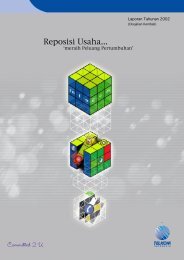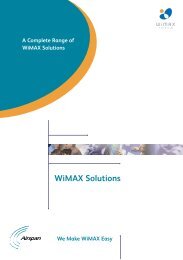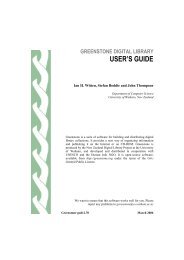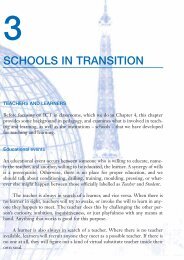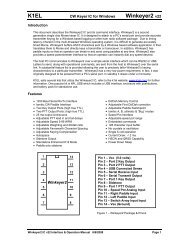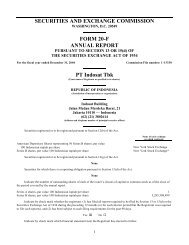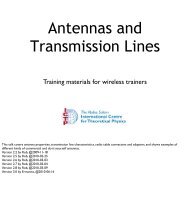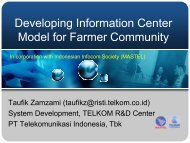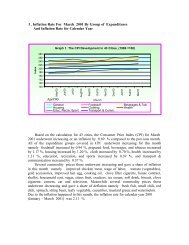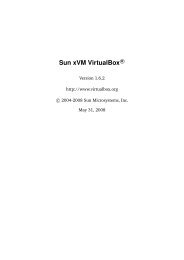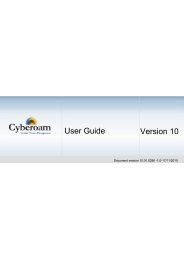Create successful ePaper yourself
Turn your PDF publications into a flip-book with our unique Google optimized e-Paper software.
Challenging the world to change<br />
Lars MarowskyBrée, SUSE Labs, Nuremberg, 01.03.04, heartbeattutorial.sxi, 1<br />
1
heartbeat deployment tutorial<br />
Lars Marowsky-Brée<br />
SUSE Labs<br />
Lars MarowskyBrée, SUSE Labs, Nuremberg, 01.03.04, heartbeattutorial.sxi, 2<br />
01.03.04<br />
2
Introduction<br />
Overview and concepts of High Availability<br />
Introduction<br />
Concepts<br />
heartbeat itself<br />
Overview<br />
Capabilities<br />
drbd et al<br />
Example configuration<br />
Other rants and topics<br />
Questions<br />
Lars MarowskyBrée, SUSE Labs, Nuremberg, 01.03.04, heartbeattutorial.sxi, 3<br />
3
Who is in the audience?<br />
Jobs:<br />
System administrators<br />
Developers<br />
Users<br />
Business people<br />
Experience<br />
First timers<br />
Experienced<br />
Gurus<br />
Go leave now ;)<br />
Lars MarowskyBrée, SUSE Labs, Nuremberg, 01.03.04, heartbeattutorial.sxi, 4<br />
4
High Availability debuzzed<br />
Faults will occur – Murphy cannot be tricked.<br />
Unmasked faults show through to the users and cause downtime<br />
(and eventually loss of money)<br />
Some faults can be effectively masked completely („fault<br />
tolerant“, „continuous availability“) and some only can be<br />
recovered from quickly („high availability“)<br />
Redundancy is important.<br />
Redundancy is important.<br />
HA is not perfect and not the same as Continuous Availability.<br />
Lars MarowskyBrée, SUSE Labs, Nuremberg, 01.03.04, heartbeattutorial.sxi, 5<br />
5
Some numbers<br />
Most people only take into account unscheduled downtime<br />
... scheduled downtime would also include the time needed for any<br />
updates or other system maintenance!<br />
Systems can „tolerate“ a certain number k of independent failures<br />
(kreliable) before total system failure.<br />
It's all about lies, damned lies and statistics<br />
Availability percentage Yearly downtime<br />
100% 0<br />
99,99999% 3s<br />
99,9999% 30s<br />
99,999% 5m<br />
99,99% 52m<br />
99,9% 9h<br />
Lars MarowskyBrée, SUSE Labs, Nuremberg, 01.03.04, heartbeattutorial.sxi, 6<br />
6
The pyramid<br />
Cost<br />
Potential market size<br />
Life support<br />
Enterprise / Datacenters<br />
Telco / Carrier<br />
SMB / SoHo<br />
Lars MarowskyBrée, SUSE Labs, Nuremberg, 01.03.04, heartbeattutorial.sxi, 7<br />
7
Increase reliability<br />
Use a stable operating system<br />
Write bugfree code!<br />
Reduce complexity KISS!<br />
Increase testing coverage<br />
QAaware processes for development and release<br />
Contain faults<br />
„Failfast“: suicide on uncorrectable faults turn hard byzantine<br />
faults into simple full failurs<br />
Deadman, hangcheck, panic on IO errors etc<br />
Find faults before they occur (Orb of Detection anyone?)<br />
Soft and hardware monitoring<br />
Lars MarowskyBrée, SUSE Labs, Nuremberg, 01.03.04, heartbeattutorial.sxi, 8<br />
8
Reduce MTTR<br />
Introduce redundancy and eliminate SPoFs!<br />
RAID redirects requests to healthy disks<br />
Failover quickly reallocates service on healthy server<br />
Load balancing redirects requests to healthy servers<br />
Site failover eventually abandons site, backup data center goes live<br />
Needs to have redundant setups to have somewhere to move to.<br />
States without redundancy are called „degraded modes“<br />
Failed systems thus need to be repaired quickly still.<br />
Introduce redundancy and eliminate SPoFs!<br />
Also:<br />
Servicelevel agreements, quick hardware replacement, good<br />
documentation<br />
Lars MarowskyBrée, SUSE Labs, Nuremberg, 01.03.04, heartbeattutorial.sxi, 9<br />
9
Single Points of Failure<br />
Infrastructure<br />
Power<br />
Air conditioning<br />
Cabling in general<br />
A single data center site<br />
Networking<br />
Connection to the Internet<br />
Intranet links<br />
Firewalls<br />
Servers<br />
Fans<br />
Disks<br />
Network cards<br />
Software<br />
Applications<br />
Lars MarowskyBrée, SUSE Labs, Nuremberg, 01.03.04, heartbeattutorial.sxi, 10<br />
The cluster manager ;)<br />
Meatware<br />
One administrator<br />
No documentation<br />
10
<strong>Clusters</strong><br />
A cluster groups resources to form a system beyond the<br />
capabilities of a single node.<br />
Availability<br />
Combined reliability of all nodes<br />
Services remain up and running even if a single node fails<br />
Remaining nodes take over<br />
Performance<br />
Combined power of all nodes operating in parallel.<br />
Distribute load among cluster members<br />
Scalable systems<br />
Lars MarowskyBrée, SUSE Labs, Nuremberg, 01.03.04, heartbeattutorial.sxi, 11<br />
11
Cluster styles<br />
Failover<br />
... is like a good magicians trick:<br />
The hand moves faster than the eye<br />
Failover within a cupboard, rack or datacenter<br />
Sitefailover to protect against disasters<br />
Different building or different continent...<br />
Loadbalanced server farms<br />
Provide load distribution, as well as protection against failed<br />
servers by shifting load away from them<br />
Linux Virtual Server<br />
Lars MarowskyBrée, SUSE Labs, Nuremberg, 01.03.04, heartbeattutorial.sxi, 12<br />
12
Distributed Systems<br />
A number of nodes interconnected via some network<br />
„Partially synchronous“<br />
Nodes:<br />
Will fail, should try to contain faults locally<br />
Assumed to have local stable storage<br />
Randomly freeze, continue, do not run in step lock<br />
Certain assumptions about network reliability, performance<br />
Links fail, packets get lost, the network gets partitioned<br />
Packets get reordered, delayed, corrupted or messed with<br />
Lars MarowskyBrée, SUSE Labs, Nuremberg, 01.03.04, heartbeattutorial.sxi, 13<br />
13
Cluster Membership<br />
Cluster needs to have a consistent view of which nodes are valid<br />
members<br />
Nodes usually heartbeat actively or are otherwise monitored<br />
Lack of heartbeats received will lead to assumption of a node<br />
failure<br />
Difficult to distinguish between link failures, node failures if all<br />
links are cut – leads to splitbrain scenarios<br />
Because failures can only be detected asynchronously, the<br />
cluster state is never certain.<br />
Lars MarowskyBrée, SUSE Labs, Nuremberg, 01.03.04, heartbeattutorial.sxi, 14<br />
14
Messaging in clusters<br />
Messages are transported via the network...<br />
kreliable: At any phase of the protocol, k failures are tolerated<br />
and recovered, thus masked for the higher levels<br />
Ordered: Global ordering is enforced.<br />
Total order: All nodes see all messages in the same order.<br />
Causal order: A message is only seen if all messages it might<br />
depend on are received.<br />
Cryptography protects against (malicious) corruption.<br />
Fun: Network partitioning and byzantine failures<br />
Lars MarowskyBrée, SUSE Labs, Nuremberg, 01.03.04, heartbeattutorial.sxi, 15<br />
15
Time in clusters<br />
With unsynchronized clocks, events could have totally random<br />
timestamps.<br />
Partially synchronized clocks (NTP) allow the assumption that<br />
any two clocks do not differ by more than ∆t<br />
To simulate strictly monotonous time, systems would never be<br />
allowed to produce a timestamp higher than that of an event<br />
received from another node. („causal“ time)<br />
Foundation on this theory done by Leslie Lamport<br />
Lars MarowskyBrée, SUSE Labs, Nuremberg, 01.03.04, heartbeattutorial.sxi, 16<br />
16
Resource Management<br />
Resource: Encapsulation of physical/logical entity providing a<br />
given service<br />
Resource type: IP address, mounted partition, httpd, Oracle...<br />
Resource Instance identified by type, name and other instance<br />
parameters<br />
A Resource Agent script handles resources of a given type,<br />
providing a common API to the Resource Manager<br />
Typically only one node can run a given resource instance at any<br />
given time, allocating it on multiple nodes will lead to data<br />
corruption and must be avoided.<br />
Typically grouped into resource groups<br />
Stack of resources needed to provide a given service<br />
Lars MarowskyBrée, SUSE Labs, Nuremberg, 01.03.04, heartbeattutorial.sxi, 17<br />
17
Crown jewels<br />
The data must be protected.<br />
Without data, there is no service.<br />
Without data, there was no service.<br />
Without data, there will be no service.<br />
Data corruption must be prevented at all costs.<br />
Rather have no running service than potentially corrupt data.<br />
Exceptions exist, but this is the safe default.<br />
Disconnect failed nodes from access to storage: Fencing<br />
Lars MarowskyBrée, SUSE Labs, Nuremberg, 01.03.04, heartbeattutorial.sxi, 18<br />
18
Accessing the data<br />
Shared storage via<br />
Fibre Channel<br />
Shared SCSI<br />
iSCSI / HyperSCSI<br />
Software replication<br />
Increasing hw reliability<br />
Replication<br />
Multipath<br />
RAID<br />
Increasing sw reliability<br />
Software RAID<br />
Replication<br />
Journaled filesystems<br />
Lars MarowskyBrée, SUSE Labs, Nuremberg, 01.03.04, heartbeattutorial.sxi, 19<br />
19<br />
Logical Volume Management<br />
Concurrent access<br />
SANaware filesystems<br />
GFS, PolyServe, IBM GPFS<br />
Distributed filesystems<br />
NFS, Lustre, AFS
IO fencing and STONITH<br />
Nodelevel fencing<br />
Shot the other node/machine in the head (aka „STONITH“)<br />
Crude, but simply effective.<br />
A powered down node does not modify data.<br />
Resourcelevel fencing<br />
Resources get to fence themselves by excluding nonmembers<br />
Disabling the FibreChannel switchport<br />
Selffencing RAID controllers<br />
SCSI reservations<br />
Caveat, emperor: Dangerous in multipath environments, not always<br />
reliable<br />
Lars MarowskyBrée, SUSE Labs, Nuremberg, 01.03.04, heartbeattutorial.sxi, 20<br />
20
Kinds of failover systems<br />
Cold<br />
Hardware ready, but not<br />
running<br />
Services are manually started<br />
on the new system<br />
Downtime very noticeable<br />
Warm<br />
System up and running, data<br />
kept in sync<br />
Services are started<br />
automatically<br />
Short outage is usually<br />
noticeable („fast reboot“)<br />
Lars MarowskyBrée, SUSE Labs, Nuremberg, 01.03.04, heartbeattutorial.sxi, 21<br />
21<br />
Hot<br />
Up and running<br />
All systems active<br />
Client talks to multiple systems<br />
at once („transaction monitor“)<br />
No noticeable outage<br />
Why isn't everything Hot<br />
then?<br />
Expensive<br />
Software has to be adapted.
Failover summarized<br />
Servers constantly heartbeat eachother.<br />
A node fails to send heartbeats for a given period of time.<br />
Other node(s) detect this, assume node has failed.<br />
Node is prevented from corrupting the data by being fenced off.<br />
Membership computed anew.<br />
New node is chosen, services are reallocated there.<br />
Called „switchover“ if not triggered by a failure, for example for<br />
taking a node out of the cluster for maintenance.<br />
„Failback“ is either done automatically or manually initiated.<br />
Lars MarowskyBrée, SUSE Labs, Nuremberg, 01.03.04, heartbeattutorial.sxi, 22<br />
22
heartbeat overview I<br />
Started by Alan Robertson in 1999<br />
Stable branch 1.2.0 (1.0.4 still supported)<br />
Development branch 1.3.0<br />
2 node warm failover for „resource groups“<br />
Either automatic failback or controlled.<br />
Simple to setup<br />
Security focus, compact code base<br />
Redundant links for heartbeating and communication<br />
Serial + IPv4 based unicast, broadcast, multicast<br />
„ping“ nodes can be added as pseudocluster members<br />
Lars MarowskyBrée, SUSE Labs, Nuremberg, 01.03.04, heartbeattutorial.sxi, 23<br />
23
heartbeat overview II<br />
Locked into memory and soft realtime for minimal latency<br />
Subsecond node death detection possible with version ≥1.2<br />
Contains many interesting components:<br />
Ipfail can monitor external conncectivity<br />
Concensus Cluster Membership layer for upto Nnodes<br />
STONITH modules, IPC library, PILS library<br />
Simple, mostly reliable cluster communication<br />
Cluster Test System (CTS) included<br />
Application heartbeating, data checkpointing etc<br />
Lars MarowskyBrée, SUSE Labs, Nuremberg, 01.03.04, heartbeattutorial.sxi, 24<br />
24
heartbeat limitations<br />
Resource management limitted to two nodes<br />
Resources themselves not monitored for failure<br />
Configuration not automatically synchronized.<br />
Little real support for replicated resource types.<br />
Lars MarowskyBrée, SUSE Labs, Nuremberg, 01.03.04, heartbeattutorial.sxi, 25<br />
25
heartbeat future<br />
Multinode functionality<br />
Dependency based resource model with constraint solver.<br />
Internal model, users will probably need a helpful GUI<br />
Automatically replicated configuration (Cluster Information Base)<br />
kreliable, causal/total ordered messaging service.<br />
Resource Agents conforming to OCF RA API<br />
Resource monitoring will be extended<br />
Ready when it is ready, but work is underway.<br />
Lars MarowskyBrée, SUSE Labs, Nuremberg, 01.03.04, heartbeattutorial.sxi, 26<br />
26
Resource Agents<br />
Allow heartbeat to manage a<br />
given resource type<br />
heartbeat also supports using<br />
init.d scripts as Resource<br />
Agents<br />
Typically written as shell<br />
scripts<br />
Take simple list of options<br />
plus a requested action<br />
Lars MarowskyBrée, SUSE Labs, Nuremberg, 01.03.04, heartbeattutorial.sxi, 27<br />
27<br />
Key points to keep in mind:<br />
Resource agents need to be<br />
able to recover from an<br />
unclean shutdown<br />
Be extra careful.<br />
For more details, refer to<br />
Open Clustering Framework<br />
Resource Agent API
Currently available RAs<br />
IPaddr, IPaddr2<br />
IPsrcaddr<br />
Filesystem<br />
LVM<br />
RAID1<br />
ServeRAID<br />
ICP<br />
LinuxSCSI<br />
Lars MarowskyBrée, SUSE Labs, Nuremberg, 01.03.04, heartbeattutorial.sxi, 28<br />
28<br />
portblock<br />
xinetd<br />
db2<br />
WAS<br />
Mostly all init.d scripts<br />
It is easy to add your own.
STONITH modules<br />
Network power switches:<br />
APC MasterSwitch<br />
WTI NPS/TPS<br />
BayTech RPCxxx<br />
Night/Ware RPC100S<br />
Serial power switches:<br />
WTI RPS<br />
APC Smart UPS<br />
IPMI over ethernet<br />
For testing only:<br />
ssh<br />
meatware<br />
(Manual operation)<br />
Lars MarowskyBrée, SUSE Labs, Nuremberg, 01.03.04, heartbeattutorial.sxi, 29<br />
29
ipfail<br />
heartbeat can monitor external nodes as pseudo cluster<br />
members by pinging them<br />
ipfail uses that information to determine where to place<br />
resources, namely on the node with the better external<br />
connectivity<br />
Dead simple configuration:<br />
Configure ping nodes<br />
Tell heartbeat to start ipfail<br />
Lars MarowskyBrée, SUSE Labs, Nuremberg, 01.03.04, heartbeattutorial.sxi, 30<br />
30
Cluster Test System<br />
CTS is the heartbeat test<br />
harness, stable releases are<br />
required to pass a few<br />
thousand iterations before<br />
release<br />
Can be extended with your<br />
own tests! (send patches!)<br />
Requires a testcontroller<br />
which orchestrates the tests<br />
on the two victim nodes<br />
syslog may lose packets<br />
Lars MarowskyBrée, SUSE Labs, Nuremberg, 01.03.04, heartbeattutorial.sxi, 31<br />
31<br />
BasicSanityCheck as a single<br />
node, straight forward sanity<br />
check of the compiled<br />
system.<br />
No hardware? No problem:<br />
UserModeLinux<br />
VMware
Top 7 rules<br />
1. Keep it simple, silly!<br />
2. Redundancy.<br />
3. Read documentation.<br />
4. Write documentation.<br />
5. Security.<br />
6. Test.<br />
7. Redundancy.<br />
Lars MarowskyBrée, SUSE Labs, Nuremberg, 01.03.04, heartbeattutorial.sxi, 32<br />
32
Common mistakes<br />
Not having the configuration<br />
files synchronized between<br />
all nodes.<br />
Controlling resources in the<br />
system init scripts and not<br />
under heartbeat's control<br />
Not using STONITH when<br />
recquired.<br />
Nodenames are casesensitive.<br />
Cheap serial cables.<br />
Lars MarowskyBrée, SUSE Labs, Nuremberg, 01.03.04, heartbeattutorial.sxi, 33<br />
33<br />
Nonredundant heartbeat<br />
media.<br />
Resource Agents which do<br />
not report to „status“<br />
correctly.
drbd present<br />
Distributed Replicated Block Device by Philipp Reisner<br />
Storage replication over the network (like RAID1) between two<br />
nodes over an „arbitary“ distance<br />
„Smart resync“ for all failure scenarios now, reducing MTTR<br />
Three protocols with different data integrity/performance tradeoffs<br />
Benchmarks show that with GigE, performance is limitted by<br />
spindle and wire speed, drbd overhead neglible<br />
Lars MarowskyBrée, SUSE Labs, Nuremberg, 01.03.04, heartbeattutorial.sxi, 34<br />
34
drbd illustrated<br />
Lars MarowskyBrée, SUSE Labs, Nuremberg, 01.03.04, heartbeattutorial.sxi, 35<br />
35
heartbeat diagram<br />
Lars MarowskyBrée, SUSE Labs, Nuremberg, 01.03.04, heartbeattutorial.sxi, 36<br />
36
ha.cf example<br />
keepalive 200ms<br />
warntime 500ms<br />
deadtime 1s<br />
initdeadtime 30<br />
auto_failback off<br />
baud 19200<br />
serial /dev/ttyS0<br />
mcast eth0 225.0.0.1 694 1 0<br />
bcast eth1<br />
stonith_host node1 rps10 /dev/ttyS1 node2 0<br />
stonith_host node2 rps10 /dev/ttyS1 node1 0<br />
node node1 node2<br />
ping 10.10.10.254<br />
respawn hacluster /usr/lib/heartbeat/ipfail<br />
Lars MarowskyBrée, SUSE Labs, Nuremberg, 01.03.04, heartbeattutorial.sxi, 37<br />
37
haresources + authkeys<br />
haresources<br />
node1 10.10.10.11 datadisk::drbd0 \<br />
Filesystem::/dev/nb0::/ha/apache::reiserfs apache<br />
node2 10.10.10.12 datadisk::drbd1 \<br />
Filesystem::/dev/nb1::/ha/mysql::ext3 mysql<br />
authkeys must be root:root, mode 0600!<br />
auth 1<br />
1 sha1 MySeCrritPassword<br />
Lars MarowskyBrée, SUSE Labs, Nuremberg, 01.03.04, heartbeattutorial.sxi, 38<br />
38
drbd.conf<br />
resource drbd0 {<br />
protocol = C<br />
fsckcmd = /bin/true<br />
inittimeout=0<br />
disk {<br />
do-panic<br />
disk-size = 4194304k<br />
}<br />
net {<br />
sync-min = 40M<br />
sync-max = 90M<br />
tl-size = 5000<br />
timeout = 60<br />
connect-int = 10<br />
ping-int = 1<br />
}<br />
Lars MarowskyBrée, SUSE Labs, Nuremberg, 01.03.04, heartbeattutorial.sxi, 39<br />
}<br />
on node1 {<br />
device = /dev/nb0<br />
disk = /dev/hdc1<br />
address = 192.168.1.1<br />
port = 7788<br />
}<br />
on node2 {<br />
device = /dev/nb0<br />
disk = /dev/hdc1<br />
address = 192.168.1.2<br />
port = 7788<br />
}<br />
resource drbd1 {<br />
...<br />
39
Standards ... and so many!<br />
Interoperability does not exist.<br />
Open Clustering Framework as a communitydriven approach<br />
Very slow going.<br />
Resource Agent API done, though<br />
Working group of the FSG.<br />
Service Availability Forum as an „Industry driven“ initiative<br />
Telco focus<br />
Closed group, expensive membership<br />
CGL / DCL OSDL wishlists keep listing clustering<br />
Lars MarowskyBrée, SUSE Labs, Nuremberg, 01.03.04, heartbeattutorial.sxi, 40<br />
40
Other projects<br />
Other failover software:<br />
RH ClusterManager<br />
WitchDoctor WDX<br />
IBM Tivoli System Automation for Linux<br />
PolyServe<br />
Related topics:<br />
Stateful firewall failover<br />
Security<br />
Denial of Service, data corruption, etc affect reliability<br />
A cluster is basically a single administrative entity<br />
„RAS“ of all sorts<br />
Hotplug of memory, CPUs, you name it<br />
Lars MarowskyBrée, SUSE Labs, Nuremberg, 01.03.04, heartbeattutorial.sxi, 41<br />
41
Single System Image<br />
Implementation by HP / Bruce Walker, ported from Tru64 and<br />
older.<br />
All nodes form a virtual single system, moving the cluster<br />
boundary even below the administrator.<br />
Clusterwide devices, clusterwide memory (NCNUMA) etc<br />
Mostly complete cluster infrastructure<br />
Fairly invasive, but still interesting.<br />
Lars MarowskyBrée, SUSE Labs, Nuremberg, 01.03.04, heartbeattutorial.sxi, 42<br />
42
Cluster Volume Manager<br />
LVM2:<br />
Proprietary Clusterextensions by Sistina<br />
EVMS2:<br />
Clusterextensions based on top of heartbeat, all Open Source<br />
Actually EVMS project contributed the CCM to heartbeat for this<br />
useage<br />
Significantly higher priority than CFS<br />
Few apps can take real advantage of concurrent access to the<br />
same filesystem still, but CVM is a real prerequisite to sensibly<br />
managing storage in a cluster<br />
Lars MarowskyBrée, SUSE Labs, Nuremberg, 01.03.04, heartbeattutorial.sxi, 43<br />
43
Linux Virtual Server<br />
Started by Wensong Zhang, very stable<br />
Load balances working on TCP/UDP layer<br />
Dedicated node acts as load balancer / firewall<br />
Need two of them, too.<br />
Virtual IP mapped via a scheduler to a set of real servers and<br />
then forwarded via NAT, „Direct Routing“ or tunneling<br />
Various scheduling methods<br />
Can replicate state table from a master LB to a secondary<br />
Layer 7 load balancing (ktcpvs) in alpha quality<br />
Lars MarowskyBrée, SUSE Labs, Nuremberg, 01.03.04, heartbeattutorial.sxi, 44<br />
44
Cluster Alias<br />
Load balancing without a load balancer<br />
All nodes bring up the same IP address – how can this work?<br />
Nodes all reply to ARP requests with a multicast MAC<br />
Only one node replies to an incoming new connection; other<br />
packets are silently ignored.<br />
(src ip, port; dst ip, port) can be used as a hash key, Cluster<br />
Manager reallocates hash buckets in case of failures<br />
IP address can be used for outgoing connections too<br />
Implementation being done right now<br />
Lars MarowskyBrée, SUSE Labs, Nuremberg, 01.03.04, heartbeattutorial.sxi, 45<br />
45
Software RAID issues<br />
Bootloader integration for RAID1 / multipath<br />
DM/MD/LVM2/EVMS2/hotplug integration still not fully designed<br />
2.6 code base is mostly a rewrite, experience from 2.4 suggests<br />
substantial testing and debugging efforts<br />
Lars MarowskyBrée, SUSE Labs, Nuremberg, 01.03.04, heartbeattutorial.sxi, 46<br />
46
Software RAID<br />
md codebase in 2.4 sucks<br />
MD codebase in 2.6 doesn't suck as badly<br />
Used for local replication & redundancy<br />
Up to one fault per RAID group can be masked for RAID>0<br />
MTTR can be reduced by added hotspares<br />
Multipathing can protect against certain media failures<br />
RAID1 on top of multipathing can provide „fault tolerance“<br />
RAID6 can mask 2 failures per array and increases spaceefficiency<br />
for bigger arrays<br />
Lars MarowskyBrée, SUSE Labs, Nuremberg, 01.03.04, heartbeattutorial.sxi, 47<br />
47
drbd vs nbd/md<br />
drbd is more tightly integrated with the version vector; failures<br />
like splitbrain, one node rebooting etc do not occur in md<br />
scenarios<br />
Close integration with the network layer makes the protocol A<br />
and B possible, which would be rather difficult to add to nbd<br />
md+nbd is more complex to setup<br />
Possibility would be to add appropriate scripting around md+nbd<br />
to ease this, but nobody steps forward to do that ;)<br />
Lars MarowskyBrée, SUSE Labs, Nuremberg, 01.03.04, heartbeattutorial.sxi, 48<br />
48
Further reading<br />
In search of clusters by Gregory F. Pfister<br />
Blueprints in High Availability by Evan Marcus, Hal Stern<br />
Fault tolerance in Distributed Systems by Pankaj Jalote<br />
Distributed Algorithms by Nancy Lynch<br />
Transaction Processing by Jim Gray<br />
http://www.lcic.org/ for more links to projects<br />
http://linuxha.trick.ca/ Linux HA Wiki<br />
http://linuxha.org/<br />
Lars MarowskyBrée, SUSE Labs, Nuremberg, 01.03.04, heartbeattutorial.sxi, 49<br />
49
No questions!^H?<br />
Lars MarowskyBrée, SUSE Labs, Nuremberg, 01.03.04, heartbeattutorial.sxi, 50<br />
50




